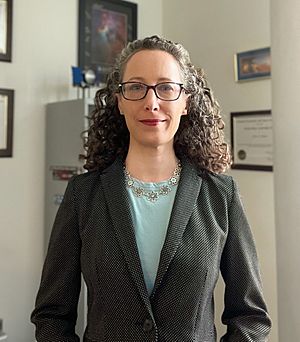Amy Simon facts for kids
Quick facts for kids
Amy A. Simon
|
|
|---|---|

Amy Simon in 2023
|
|
| Born | October 1971 Union, New Jersey, U.S.
|
| Alma mater | Florida Institute of Technology New Mexico State University |
| Children | 1 son |
| Scientific career | |
| Fields | Planetary atmospheres Robotic exploration |
| Institutions | Cornell University Goddard Space Flight Center |
Amy Simon is an American scientist who studies planets. She works at NASA's Goddard Space Flight Center. She helps with many important missions that explore our Solar System.
Contents
Her Journey to Becoming a Scientist
Amy Simon grew up in Union Township, Union County, New Jersey. She went to Union High School there.
She studied Space Sciences at the Florida Institute of Technology. She earned her first degree in 1993. Later, she got her advanced degree in astronomy from New Mexico State University in 1998. After that, she worked as a researcher at Cornell University.
What Amy Simon Does at NASA
Amy Simon is a Senior Scientist at NASA's Goddard Space Flight Center. She joined NASA in 2001. She has led different teams there, including the Planetary Systems Laboratory.
Her main work is studying the atmospheres of giant planets like Jupiter and Saturn. She looks at what they are made of, how they move, and what their clouds are like. She uses information from spacecraft to do this. As of 2023, she has written over 160 scientific papers.
Amy Simon also helps plan future space missions. She has been part of many robotic missions that explore space.
Discoveries and Missions
Amy Simon has made many important discoveries. She was the first to study how Jupiter's Great Red Spot changes shape. She also found new types of waves in Jupiter's atmosphere. She used images from spacecraft like Voyager 2, Cassini-Huygens, and New Horizons. She also used the Hubble Space Telescope.
She has also studied Saturn's atmosphere, including the strange hexagon shape at its north pole. She helped a team that observed Neptune using the Kepler space telescope. They were able to see how light reflected off Neptune changes due to the Sun.
Amy Simon is involved in many NASA missions. She worked on the Cassini-Huygens mission. She is also a deputy scientist for instruments on the OSIRIS-REx and Lucy missions. She also works on an instrument for the Landsat 9 satellite.
Since 2014, she has led the Hubble Outer Planet Atmospheres Legacy (OPAL) program. Her team found a new Great Dark Spot on Neptune using the Hubble Space Telescope. Her work with the OSIRIS-REx mission led to finding water-rich minerals on the asteroid Bennu. This earned her a special award from NASA.
Planning Future Space Exploration
Amy Simon helps plan what planets NASA will explore next. She was part of a group that decided what planetary science missions NASA should focus on. She has helped lead studies for big missions to places like Enceladus and the Ice Giants, Uranus and Neptune. She also led a proposal for a mission to Saturn called SPRITE.
She is a member of several important science groups. These include the American Geophysical Union and the American Astronomical Society.
Awards and Recognition
Amy Simon has received many awards for her amazing work:
- American Astronomical Society, Division for Planetary Sciences Claudia J. Alexander Prize - 2023
- Meritorious Senior Professional Presidential Rank Awards - 2022
- NASA Outstanding Leadership Medal – 2020
- John C. Lindsay Memorial Award for Space Science - 2020
- NASA Exceptional Scientific Achievement Medal – 2019
- NASA Silver Achievement Medal (OVIRS Team) – 2017
- NASA Group Achievement Award (OSIRIS-REx Team) – 2017
- Robert H. Goddard Science Achievement Award (Hubble OPAL Team) – 2016
- Robert H. Goddard Engineering Achievement Award (OVIRS Team)
- NASA Exceptional Service Medal – 2016
- Robert H. Goddard Exceptional Engineering (OVIRS Team) – 2014
- NASA Exceptional Service Medal – 2014
An asteroid, 84994 Amysimon, was named after her in 2014. It was discovered in 2003. The official naming citation was published by the Minor Planet Center on May 14, 2014 (M.P.C. 88406).

